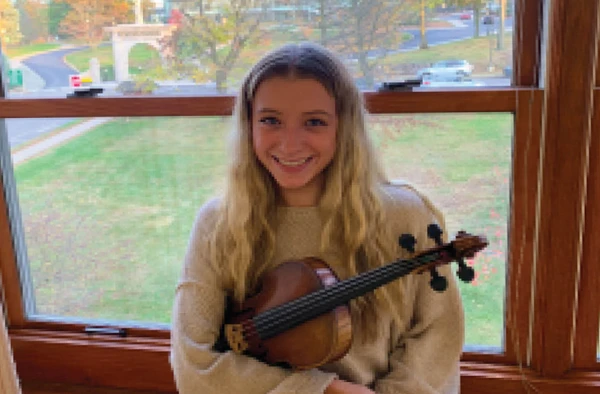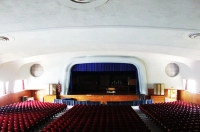Bachelor of Arts in Arts Administration - Music (BA)
- Music, Theatre, and Dance
- The Michael & Dolores Insalaco School of Visual & Performing Arts
- Reap College of Creative and Professional Studies
Fully Accredited
Marywood University is accredited by the Middle States Commission on Higher Education (MSHE). / ADDRESS / 3624 Market Street, 2nd Floor West, Philadelphia, PA 19104. | Phone: (267) 284-5000
The Bachelor of Arts (B.A.) in Arts Administration (Primary concentration in Music) is Accredited by the National Association of Schools of Music (NASM).
PROFESSIONAL MEMBERSHIPS / National Association for Music Education (NAfME) / Pennsylvania Music Education Association (PMEA).
Elevate Your Career with Marywood’s Arts Administration with a Concentration in Music!
Marywood University's Bachelor of Arts in Arts Administration with a concentration in Music offers a distinctive blend of music education and business management, preparing you for a variety of roles in the arts sector. Our curriculum includes courses in music theory, history, and performance, alongside business courses covering marketing, finance, and management tailored to the arts industry. Students may choose a concentration in either music or theatre. They must also choose a secondary concentration in music, theatre, or art.
What sets our program apart is the emphasis on real-world experience and professional readiness. Through internships, projects, and collaborations with arts organizations, students gain practical skills directly applicable to their future careers. Our dedicated faculty, seasoned in both music and business, provide personalized guidance and mentorship, ensuring you build a strong network within the arts community. Graduates are equipped to lead and innovate in arts administration, contributing significantly to cultural institutions and educational programs.

The teachers stood out to me at Marywood. Meeting with Sophie Till, associate professor of violin and viola, was the deciding factor in choosing Marywood. Faculty absolutely play a key role in the final decision process. I love seeing students being more confident in their abilities. When students are able to walk away, and they’re able to do something new—that’s what it’s all about. I was shy and introverted before coming to Marywood, but as a result of my experiences and knowledge gained here, I have definitely come out of my shell.
Emily Felker '21 Read All Testimonials
Outcomes & Opportunities
Top Employers
- Music/Recording Industry
- Musical Arts Institutions
- Concert Venues
- Colleges and Universities
Top Career Paths
- Arts Administrator
- Arts Educator
- Cultural Venue Director
- Media Manager
Dig Deeper Into the Program Details
If you have any questions about this program, we're here to help.
Undergraduate Admissions Requirements
- Completed application
- Official transcripts
- Letter of recommendation
- Official SAT and/or ACT test scores (Marywood is test optional)
- Essay (optional)
All Undergraduate & Transfer Students
Acceptance by the University is required before an audition can be scheduled.
- Apply to University.
- FAFSA Deadlines for financial aid: February 15 (fall entry) and November 1 (spring entry).
- For talent scholarship consideration, auditions must be completed by March 1.
- Transfer students must complete a minimum 30 credits in music courses at Marywood. Transfer students in education must have GPA 3.0 minimum for acceptance.
Accompaniment
Instrumental applicants should plan to perform unaccompanied.
An accompanist will be provided for vocal auditions.
General Guidelines for All Auditions
Perform two contrasting works demonstrating technical skills and musicianship (see below for suggested repertoire by instrument). Memorization of vocal audition pieces is strongly recommended.
Skills Assessment
Sight-Singing and Sight-Reading
Sight singing and sight reading are a part of all auditions.
All auditioning students will be asked to take a short music theory test. This test is used only for placement and does not impact acceptance in our programs.
Suggested audition repertoire (by instrument)
Vocal
- Art song (in Italian, French, or German)
- Contemporary classical or folk selection in English
Keyboards
Piano
Two contrasting works from different compositional periods (Baroque, Classical, Romantic, and Contemporary)
Organ
- Classical work from standard organ repertoire
- Two verses of a traditional hymn: (1) include appropriate introduction; (2) first verse played as written; second verse may be a re-harmonization or improvisation based on first verse
- Technique exercises (facility on manuals and pedals)
Woodwinds & Brass
- Flute; Clarinet; Saxophone; Oboe; Bassoon
- Trumpet; Horn in F; Trombone; Euphonium ; Tuba
- Two contrasting audition excerpts (technical v. lyrical skills) from standard winds repertoire Audition selections 3-5 minutes length. Excerpts may be major concerto, sonata, or solo work
- Major scales ascending and descending (multiple octaves when possible) with articulations as determined by audition committee.
Percussion
Applicants should bring drum sticks and mallets and demonstrate proficiency on multiple instruments.
- Snare Drum: Concert-style snare drum solo demonstrating concert rolls, flams, ruffs
- Drum Set (Optional): drum set proficiency in swing, rock, & Latin styles
- Keyboard Percussion/Mallets: Two-mallet solo from standard repertoire required (Optional: four-mallet solo demonstrating skill level)
- Timpani: Timpani solo on at least two timpani, including rolls. Demonstrate ability to tune timpani from a given piano reference pitch
Strings
Violin; Viola; Cello; Harp; Double Bass
- Two stylistically contrasting movements (technical v. lyrical) from standard classical repertoire demonstrating performance skills as soloist
- Major/minor scales (2-octaves)
Acoustic Guitar
- Two stylistically contrasting solo pieces from standard classical repertoire
- Major/minor scales (melodic minor form, 2- or 3-octaves)
Electric Bass Guitar
- Two contrasting jazz pieces, melody
- An improvised bass line and bass solo
- Major/minor scales, arpeggios (2-octaves)
The Sette LaVerghetta Performing Arts Center (PAC) is a three-story structure located on the western edge of campus that houses the Music, Theatre, & Dance (MTD) department within the College of Arts and Sciences. The MTD department is comprised of faculty offices and studios, classrooms and practice rooms, music therapy lab and clinical observation room, small recital room, dance studio, Black Box Theatre, and main stage theatre.
The Performing Arts Theatre is the main stage theatre and recital hall for all University-related events. This large 1100-seat performance space contains a proscenium stage, orchestra pit, dressing rooms, box offices, control room, backstage area and the ability to fly scenery. Other features include sound and lighting boards, a 9-foot Steinway grand piano and 7-foot Steinway grand piano (on stage), a Mason & Hamlin grand piano (orchestra pit), and large Allen electronic organ.
PAC Room 104 (first floor) is used as a student recital hall, large-ensemble rehearsal space, and meeting room. It houses two grand pianos and has a raised stage for performances. Two classrooms, the music therapy lab and observation room, and music therapy faculty offices are also located on the first floor. The second floor houses teaching studios, ten practice rooms containing both upright Yamaha and Grand pianos, a small harp studio with three harps, guitar studio, and faculty offices.
Music Therapy Research Lab (Room 106, first floor) contains biofeedback equipment interfaced on PC (Electromyography/EMG -2 channels), Temperature, Skin Conduction (2 channels). Also included are stand-alone biofeedback instruments: Resp@Rate; OMRON and a Marshall-Auto-Oscillometric Electronic Digital Blood Pressure and Pulse Monitor with Print-Out. The Music Therapy Clinic (Room 106, first floor) is a fully-supervised clinical setting complete with a one-way mirror for observations. University music therapy students, under the supervision of the clinic coordinator, offer weekly services to community individuals with special needs.
Computer Lab (first floor) is an open lab classroom with sixteen MAC computers for student use. In addition to Microsoft Office and Internet capability, software applications include set/lighting design and scriptwriting.
The Electronic Music Lab (second floor) has eight computers with Internet access and Sibelius music-writing software; eight portable MIDI keyboards; two full-size electronic keyboards; and mixers. The Piano Lab (second floor) contains twelve Yamaha Clavinova electronic pianos in addition to a master piano, each featuring a full-sized touch-sensitive keyboard. Piano Lab also houses a MAC computer. Music scores library/storage space for choral and orchestral music is also located on the second floor. Six large classrooms and a student lounge are located on terrace floor/lower level.
Black Box Theatre (terrace floor/lower level) is a laboratory theatre designed with flex staging to accommodate student-directed productions and to support experimental theatre.
Across campus, The Swartz Center, adjacent to Loughran Hall houses the University chapel and is a dual-use space. The chapel offers the music department an intimate 180-seat performing space. Completely renovated in 2007, the Marian Chapel (formerly the IHM Marian Convent), boasts a new Peragallo pipe organ and new 7-foot Steinway grand piano.
The Latour Room - located in Nazareth Hall Student Center, is a large multi-purpose venue that is occasionally used for music rehearsals and concerts.
The Rotunda, a large, multi-story dome clad in marble at the center of the Liberal Arts Center, is a main focal point of the campus. It is an especially effective performing space for unaccompanied vocal ensembles.

Sette LaVerghetta Center Theatre
2300 Adams AvenueMap & Directions
The Sette LaVerghetta Center Theatre is a 1,100-seat main stage theatre and concert hall for all University-related events.
Learn More

Sette LaVerghetta Center for Performing Arts
2300 Adams AvenueMap & Directions
The Sette LaVerghetta Center for Performing Arts is a three-story structure that houses the Music, Theatre, & Dance (MTD) department. The facility includes a 1110-seat performance space which contains a proscenium stage, orchestra pit, dressing rooms, box offices, control room, backstage area and the ability to fly scenery. Other features include sound and lighting boards, a 9-foot Steinway grand piano and 7-foot Steinway grand piano (on stage), a Mason & Hamlin grand piano (orchestra pit), and large Allen electronic organ. The facility also houses several studios, classrooms and practice rooms, a music therapy lab and clinical observation room, recital room, dance studio, electronic music lab, piano lab, and a Black Box Theatre.
Learn More | Take a Virtual Tour

Rotunda
Map & Directions
The Rotunda, an iconic campus landmark, is part of the Liberal Arts Center. It features historic murals by Roman artist Gonippo Raggi and the Hall of Presidents. The Admissions Office is adjacent to the Rotunda.
Learn More
Scholarships
Morris K. Udall Scholarship
The Udall Foundation seeks future leaders across a wide spectrum of environmental fields, including policy, engineering, science, education, urban planning and renewal, business, health, justice, and economics. The Foundation also seeks future Native American and Alaska Native leaders in public and community health care, tribal government, and public policy affecting Native American communities, including land and resource management, economic development, and education.
Tuition
View Tuition Rates- School Director (Co-Director)
- Associate Professor
- rhoffenberg@marywood.edu
- 570-348-6211 x2537
- Interim Director, Music Therapy Program
- Instructor of Practice
- amfox@marywood.edu
- Director, Theatre Program
- Associate Professor
- tpyles@marywood.edu
- 570-961-4726
- Director, String Project
- Associate Professor
- sophietill@marywood.edu
- 570-348-6211 x2378
- Technical Director/Production Manager
- rhouser@marywood.edu
- 570-348-6211 x2960
MTD Student Handbook
The information in this handbook is designed to familiarize you with university and department policies specific to the MTD degree programs.
Please save this handbook, as it will provide guidance throughout your studies at Marywood. Bring this handbook to all academic advising sessions.
From #DayOne, Marywood is here for you each step of the way.
Request Information
Latest Program News & Events
Admissions Calendar
Fully Accredited
Marywood University is accredited by the Middle States Commission on Higher Education (MSHE). / ADDRESS / 3624 Market Street, 2nd Floor West, Philadelphia, PA 19104. | Phone: (267) 284-5000
The Bachelor of Arts (B.A.) in Arts Administration (Primary concentration in Music) is Accredited by the National Association of Schools of Music (NASM).
PROFESSIONAL MEMBERSHIPS / National Association for Music Education (NAfME) / Pennsylvania Music Education Association (PMEA).





- Facebook
- Twitter
- YouTube
- Instagram
- Snapchat
- LinkedIn
- TikTok
#PacerPride